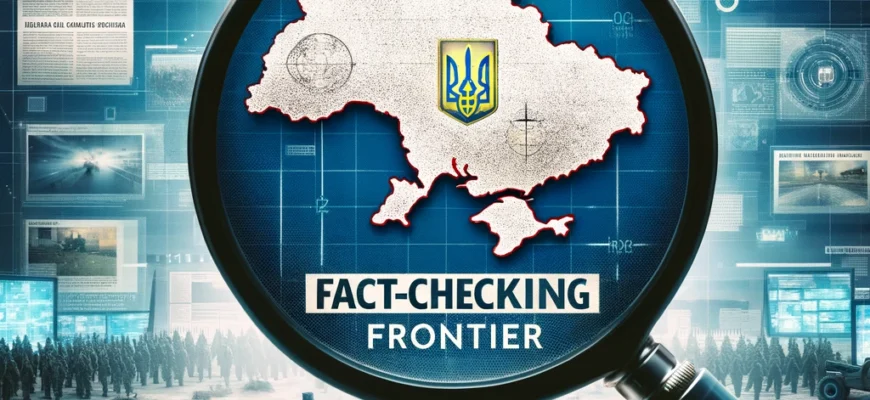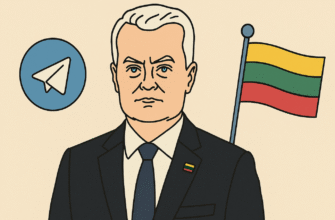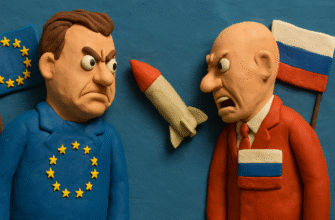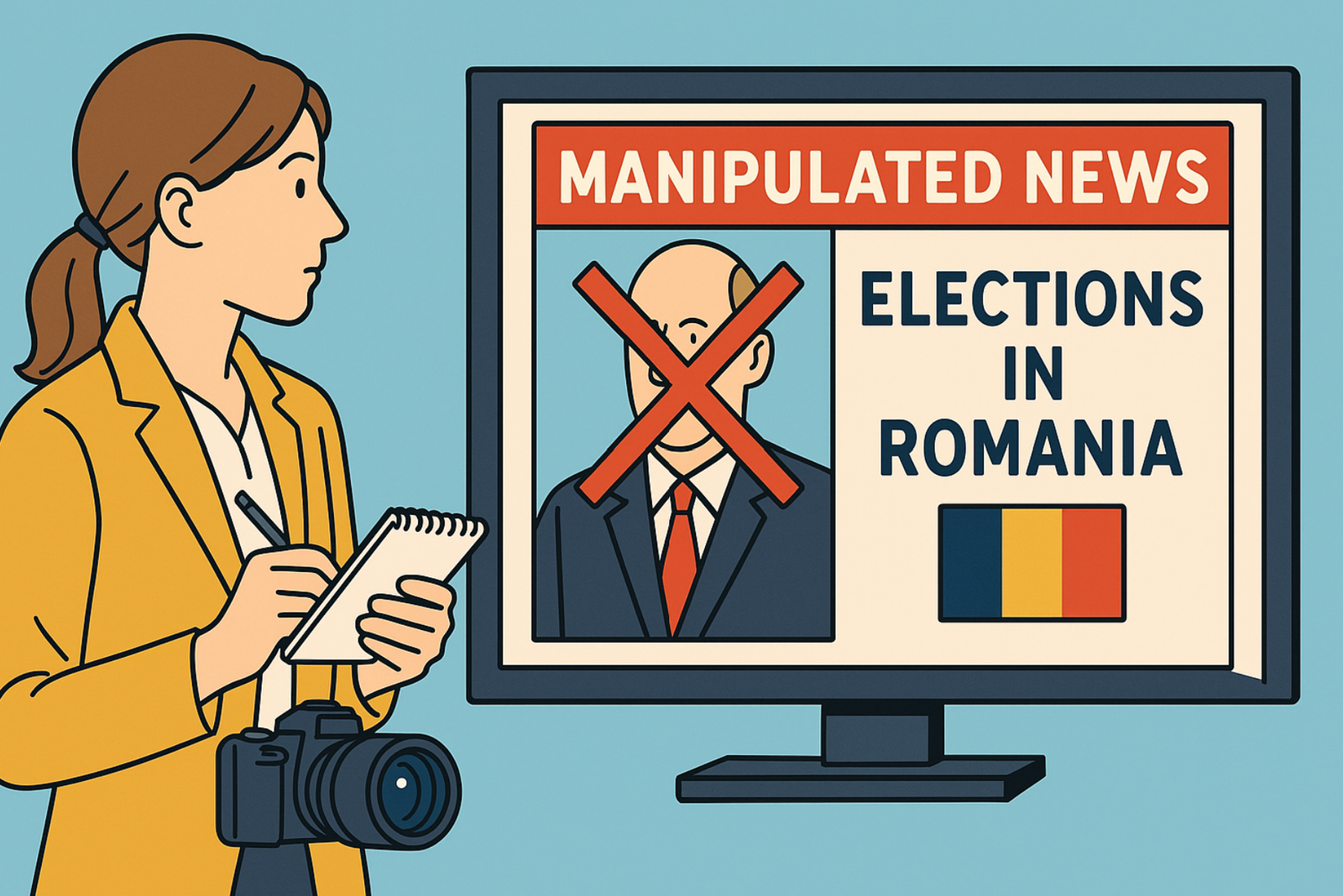This is a special issue dedicated to the second anniversary of the brutal full-scale invasion of the Russian Federation into Ukraine and ten years since the illegal annexation of Crimea and the first military intervention in Donbas.
Looking at the Google Trends data over two years, the number of queries from the Belarusian internet audience, which is in the country, on the topic of the Russian-Ukrainian war has significantly decreased:
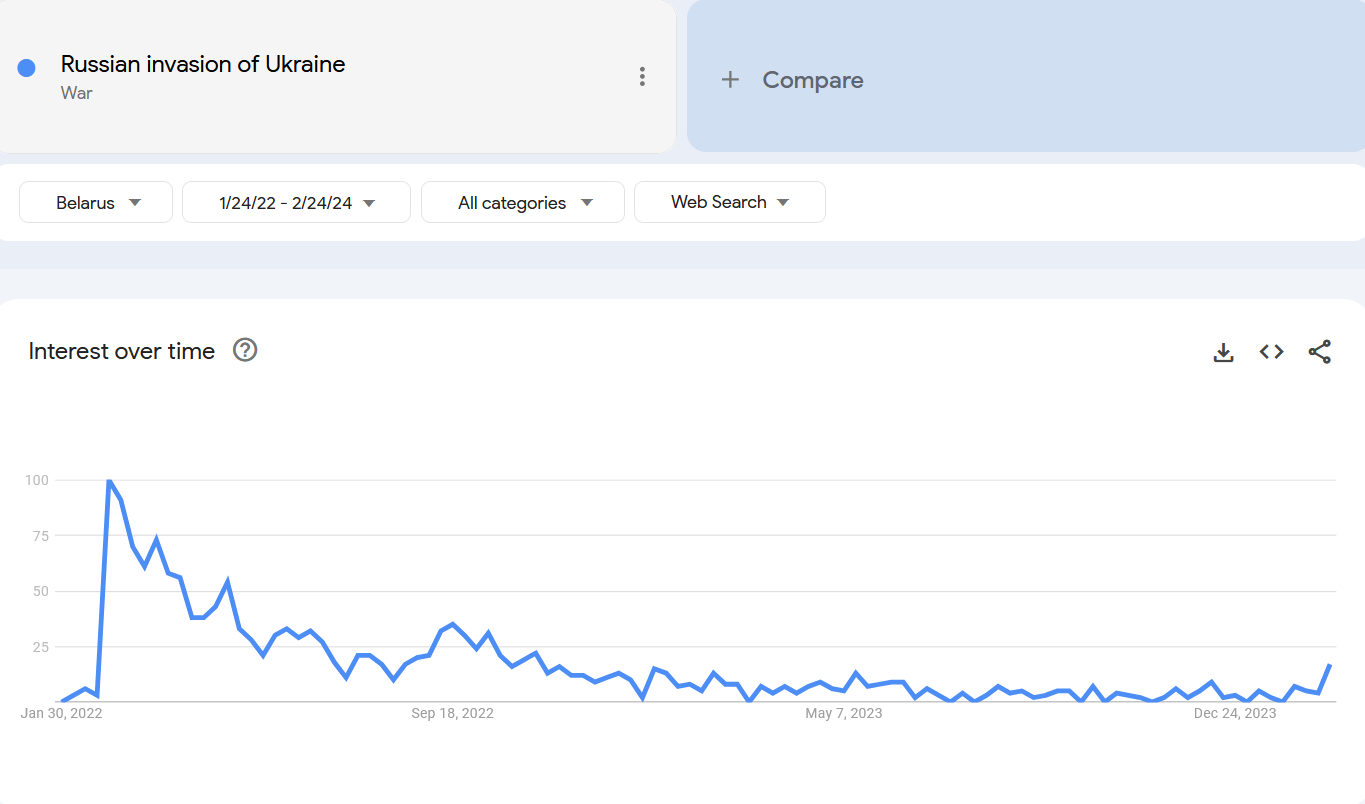
One of the goals of this issue of Fact-Checking Frontier is to demonstrate how the global fact-checking community, fighters against disinformation, against Russian propaganda, prepared materials for the next anniversary of the monstrous crime against humanity.
Let’s see what publications were prepared in different countries.
Kazakhstan
The 5 most important fact checks about the war in Ukraine
Russia began its full-scale invasion of Ukraine exactly two years ago. During this time, the Factcheck.kz editorial team prepared more than 70 checks of misinformation around the war and twice summarized the most read materials.
Factcheck.kz
Publication: https://factcheck.kz/dekonstrukciya-propagandy/5-samyh-vazhnyh-faktchekov-o-voyne-v-ukraine
Moldova
Watchdog.MD prepared a video:
The description says:
Today, it is clear how great the danger posed to us by Putin is. Moldova has officially recognized Russia as the main security threat to the country. We continue to resist attempts to destabilize us by both old and new politicians, directly controlled from Moscow, fake pro-Europeans, and openly pro-Russian politicians. We have been safe for two years only because the Ukrainian army is losing lives on the battlefield, and the Russian army cannot reach Moldova. Let’s not allow ourselves to be manipulated by those who have long kept silent and have not condemned Vladimir Putin directly and loudly, have not clearly and directly stated that Russia is to blame for the slaughter in Ukraine, that Russia is the main danger to Moldova today.
🙏Condolences to the families who have lost children, fathers, mothers, brothers, sisters, grandparents, friends, neighbors, relatives on the battlefield in Ukraine.
Spain
Since the beginning of Russia’s attack on Ukraine in February 2022, dozens of videos and images allegedly related to the invasion have been circulated online, but many of them are outdated and were not recorded in this Eastern European country. Spanish fact-checkers from Maldita.es debunked more than 170.
This map shows in which countries members of the International Fact-Checking Network IFCN have identified and debunked disinformation about the invasion of Ukraine:
This war has become the first hybrid war of the 21st century. While battles rage in Ukraine, disinformation was spread on social media and in the media with the goal of influencing public opinion.
For the second anniversary of this war, Spanish INFOVERITAS collected disinformation stories about this conflict that circulated from screen to screen.
Latvia

Fact-checkers from Re:baltica reported that a message warning people in Latvia not to answer calls from numbers starting with +380, 055, 045, 065, claiming that even incoming calls would be charged to benefit the Ukrainian army, is fake. Such a warning with a suggestion to pass it on was published on social networks in Latvia. It is most likely a fake news story created in Russia.
Italy
As Facta writes, whilethe battle continues on the front and the Ukrainian army resists and repels the attacks of the Russian army, a parallel war is taking place on our computers and mobile phones, when Russia uses disinformation, propaganda, and conspiracy theories to justify its invasion, silence internal opposition, and sow discord among its opponents, as explained by Associated Press last year. In September 2022, the EU DisinfoLab, an independent non-profit organization that analyzes disinformation in Europe, discovered a campaign called “Doppelganger”, operating in Europe at least since May of the same year and based in Russia. Using numerous “clones” of European media outlets (including Bild, 20 minutes, Ansa, The Guardian, or RBC Ukraine), fake articles, videos, and polls were spread with the goal of promoting the Kremlin’s narrative about the war in Ukraine, including using social media profiles to amplify these messages.
Similar operations continue today. Just a few days ago, the newspaper Washington Post reported news on a media strategy adopted by the administration of the President of Russia, based on the analysis of Kremlin documents obtained by European intelligence. This strategy involves the creation of thousands of social media posts and hundreds of articles with fabricated news, spreading throughout Ukraine and across Europe aimed at weakening the political figure of the President of Ukraine, Volodymyr Zelensky, and to fracture and destabilize Ukrainian society. On February 13 last year, representatives of the French Ministry of Foreign Affairs reported on Russia’s intensified efforts to manipulate information on social networks, directed against Kyiv’s allies in the West. In Germany, computer forensic experts last month identified an extensive pro-Russian disinformation campaign against the country’s government using tens of thousands of fake accounts.
From the first day of the war, this conflict has been among the most targeted by disinformation in Europe, as documented monthly by the European Digital Media Observatory (EDMO), a center composed of fact-checking professionals, media literacy experts, and scientists. For this reason, over these two years, we at “The Fact” have verified a lot of disinformation content in this regard, encountering various types and forms of unfounded information aimed at discrediting the military-political authority of Ukraine and its allies in public opinion.
However, recently we have noticed a variant of pro-Russian disinformation, more complex and detailed than the “simple” individual mystifications. In recent months, videos from individual accounts of ordinary citizens have been published on social networks, revealing “sensations” about Zelensky and his family, mixing fake documentary evidence and real news. The mechanism through which this content appeared as independent investigations “from below” or exposés of supposed informants. A method that helped give the stories a certain credibility, useful for making them perceived as detached from party interests, which public opinion usually associates with political groups or so-called mainstream media.
The fake news spread in this way was disseminated in several languages and went viral in many countries through sites associated with Russian propaganda, shot and re-launched by Russian authorities themselves and pro-Russian influencers. In one case, one of these fabricated stories even impacted political debates in the USA regarding aid packages to Ukraine.
France
Fact-checkers from AFP report that two years after Russia began its invasion of Ukraine, Russian President Vladimir Putin continues to call the “neutral status” of Ukraine one of the preliminary conditions for ending the conflict. In this context, internet users are sharing videos on social networks of a French pro-Russian group, in which the speaker claims that “Ukraine’s neutrality” was enshrined in its Constitution “from the very beginning.” However, there has never been such a mention in the Constitution of independent Ukraine, a fact checked and confirmed by seven AFP experts on the subject. They further explain that while Ukraine briefly defended the principle of neutrality in its Declaration of Sovereignty in 1990, this stance – non-constitutional at the time – was aimed at protecting it from Russian influence, not to prevent Ukraine’s integration into NATO, contrary to what is shown in the video.
Hungary
Lakmusz publishes the five wildest methods of Russian disinformation:
- Fake fact-checking websites, which are actually sham fact-checking sites spreading Russian state propaganda under the guise of professional methodology. One of the most notorious of these sham sites is War on Fakes. This page and its various Telegram channels were created simultaneously with the beginning of the Russian invasion, described as “providing objective information about what is happening in Ukraine” while being perceived as “an information war against Russia.” The site’s uniqueness lies in its imitation of real fact-checking websites’ methods and the use of visual tools, such as photos with a red “FAKE” mark, to deceive.
- Using genuine newspapers to support false information. To spread false information, they attempt to mimic the appearance of media considered authentic: sometimes, falsehoods are published in the name of well-known, reputable press.
- Tactical overload on journalists, i.e., the volume of information journalists need to verify
- When disinformation costs human lives. However, disinformation campaigns can be aimed not just at disinformation, influence, or creating uncertainty, but in the most serious cases, these actions can even lead to civilian casualties. The organization CIVIC (Center for Civilians in Conflict) identified that a large part of Russian disinformation was directed specifically at the Ukrainian civilian population, to influence their behavior and thereby in many cases put them at risk. This included, for example, spreading false information about the time or place of evacuation or claims that the Ukrainian army was blocking evacuation routes and attacking peaceful Ukrainians trying to flee.
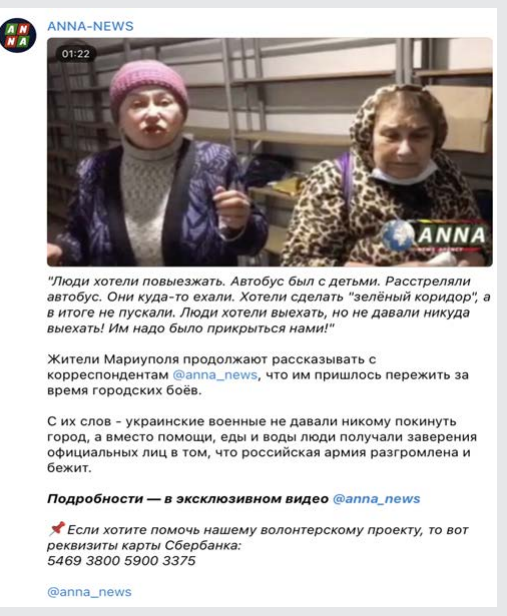
CIVIC documented several cases of this method’s use. For instance, on March 17, 2022, a video was published on the social media page of the pro-Russian media ANNA News, in which peaceful Ukrainians talked about being shot at by a bus trying to evacuate them. It is still available on Telegram, where an elderly woman talks about how the Ukrainian army did not allow them to cross into Ukrainian territory from Mariupol. At that time, ANNA News had over 334,000 subscribers, and the video was shared more than 53,000 times in the first hour. - Filling the information vacuum with fake news
Countless examples prove that the goal of Russian propaganda is to “make noise,” flooding the public with false, even contradictory information, to completely disorient readers. The disinformation machine kicks in almost automatically with the emergence of any news of significant interest. One of the latest examples is the death of Alexei Navalny.
Serbia
Serbian fact-checkers write that persistent propaganda and anti-Western narratives, attacks on Volodymyr Zelensky, and the revival of old conspiracy theories have marked the second year of the war from the standpoint of disinformation, which they have observed and analyzed over the past 12 months.
Посмотреть эту публикацию в Instagram
Much of the deconstructed disinformation in the first year of the war could be encapsulated within manipulative constructs claiming that the West is to blame for the war in Ukraine and seeks to destroy Russia, that Ukraine is a Nazi state, that Ukraine stages victims (and the West helps them), that Russia is strong, while Ukraine is weak.
Photo montages, manipulations with filmed material, deceit, fabrication, misinterpretation – these are some of the techniques employed after the war began. The same patterns were noted last year as well. Manipulation and propaganda techniques continue to flow from one social network to another.
Over the last year, “Istinomer”/Istinomer caught and analyzed nearly 40 specific disinformations related (and indirectly) to the war in Ukraine. Compared to 2022, this is twice as many.
Among the specific manipulation techniques, the most prevalent remain the misuse of visual content, unverifiable claims, and the persistent repetition of old conspiracy theories.
Logically Facts
Described the situation in Ukraine, stating that the morning of February 24, 2022, changed the journalistic landscape in Ukraine. Reporters now face unprecedented challenges and bear greater responsibility, adopting new technologies, using social media, and often risking their lives to provide ground reports.
In the chaos of conflicts, fact-checking organizations have become key players. Ukrainian media increasingly incorporate fact-checking units and OSINT methodologies into their reporting processes. For example, digital investigation experts from AFP and APA trained a group of journalists from the Ukrainian news agency “Ukrinform” and helped them immediately start conducting their own fact checks.
Even before the war in Ukraine, several independent fact-checking organizations were already operational, such as VoxUkraine, StopFake, and “Without Lies“. New initiatives like “Gvara”, which is now a member of the International Fact-Checking Network (IFCN), began emerging immediately after the start of the full-scale war. Initially created in response to the disinformation campaign around the annexation of Crimea in 2014 and the conflict in Eastern Ukraine, StopFake has become one of the most renowned fact-checking organizations in the country, now conducting fact checks in 14 languages.
The new working environment has presented Ukrainian fact-checkers with new challenges, stemming from the nature of the conflict and the broader information ecosystem in which these organizations operate.
The war led to an explosion of disinformation and propaganda, much of which was deliberately spread to sow confusion, fear, and discord. The scale of the information war complicates the task of fact-checking to ensure accurate and timely verifications.
“In this war, Russia has employed a multitude of digital technologies for disinformation: deepfakes, voice forgeries, facial identification manipulations. A fact-checker must be able to cope with all this and do so quickly,” says Victoria Romanyuk, deputy chief editor and co-founder of StopFake.
Alexander Gorokhovsky, founder of the anti-disinformation project “Without Lies”, adds: “For us, these are fakes, but for them [Russians] — it’s news.”
Recently, StopFake exposed manipulations involving prominent media, as well as disinformation related to aid provided to Ukraine by Western partners, and issues regarding mobilization processes.

As stated in today’s NATO-Ukraine Council Statement on the second anniversary of Russia’s full-scale invasion of Ukraine
We pay tribute to those who have died and condemn the tragic suffering of people and the destruction caused by Russia’s illegal, unjustified, and unprovoked war. Russia is failing in its attempts to undermine the statehood of Ukraine and break the resolve of the Ukrainian people. Ukraine is prevailing as a sovereign democratic state, having liberated a significant portion of its territory and pushing back the Russian Black Sea Fleet.
Russia bears full responsibility for this war, which is a gross violation of international law, including the UN Charter, and must be held fully accountable. War crimes, violations, and abuses of human rights and international humanitarian law, including the forced deportation of children and sexual violence in conflict, must not go unpunished. We condemn Russia’s horrific strikes on Ukrainian cities and its civilian, energy, and port infrastructure, some of which have also affected the territory of member states. We also condemn those who facilitate the Russian war and amplify Russian disinformation. Russia must immediately cease this war and fully and unconditionally withdraw all its armed forces from Ukraine in accordance with UN General Assembly resolutions. We do not recognize and will never recognize Russia’s illegal and illegitimate annexations, including Crimea. Russia has shown no true openness to a fair and lasting peace.

